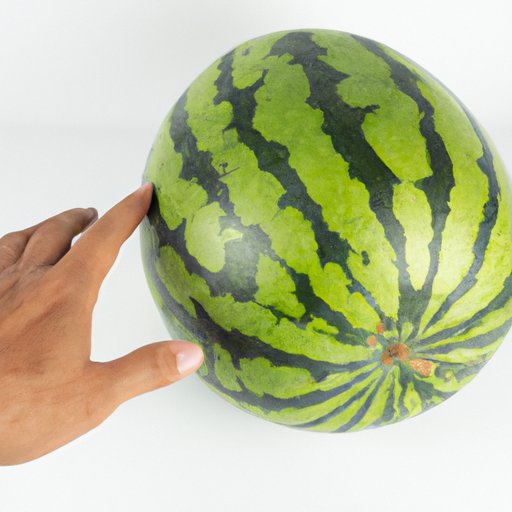
Introduction
Watermelon is a refreshing and sweet fruit that’s perfect for hot summer days. However, there’s nothing worse than cutting into a watermelon only to find out that it’s unripe or flavorless. So, how do you tell if a watermelon is good before making a purchase? In this article, we will cover several reliable methods for selecting the perfect watermelon.
Appearance
The first way to tell if a watermelon is good is by examining its appearance. A good watermelon should have a symmetrical shape, distinct stripes, and a creamy yellow underside. A lopsided or irregularly shaped watermelon may indicate that it didn’t grow evenly. Additionally, the stripes on the watermelon should be varying shades of green and have a consistent width. Any break in the stripes may indicate that the fruit didn’t develop correctly.
Why is appearance important? These visual cues indicate that the watermelon received adequate sunlight and water while growing. A healthy watermelon will also have a thick rind and few blemishes.
Weight
Another way to tell if a watermelon is good is by judging its weight. A ripe watermelon should feel heavier than it looks. This is a sign that the fruit is full of water and ripe. A watermelon that feels lighter than it looks may indicate that it’s unripe, dried out, or has been sitting out for too long.
Why is weight important for determining the quality of a watermelon? A watermelon’s weight is a reliable indicator of its ripeness. A good watermelon should feel dense and full of water.
You can also use the thudding test to determine if a watermelon is good. To conduct the test, hold the watermelon close to your ear and tap it gently. If the sound is deep and hollow-sounding, then the watermelon is ripe and juicy. However, if the sound is high-pitched or dull, then the melon may be unripe or overripe.
Texture
The texture of a watermelon is another way to tell if it’s good. A ripe watermelon should feel firm when pressed, but it should also give a little. If it’s too hard or too soft, then it may be unripe or overripe.
Why is texture important for determining the quality of a watermelon? A good watermelon should have a crisp and juicy texture. Watermelons that are too hard may be unripe, while those that are too soft or mushy may be overripe.
Smell
The sweet fragrance of a watermelon is a sure sign that it’s ripe and juicy. To determine if a watermelon is good, you can smell the blossom end of the fruit. If it smells sweet and ripe, then it’s probably a good watermelon. If it doesn’t have a fragrance, then it may be unripe or flavorless.
Why is smell important for determining the quality of a watermelon? A sweet fragrance indicates that the watermelon is ripe and full of flavor. Watermelons without a fragrance may not be fully ripe, and therefore, they may not be delicious.
Sugar Spot
The sugar spot on a watermelon is a yellowish discoloration located where the melon was resting on the ground. The sugar spot is a reliable indicator of a sweet watermelon. A large, dark sugar spot indicates that the watermelon is probably sweeter than a fruit with a small or light-colored spot.
Why is the sugar spot important for determining the quality of a watermelon? The sugar spot indicates the amount of time the watermelon spent on the vine. The longer it stays on the vine, the more sugar it develops, which results in a sweeter fruit.
Flavor
Lastly, the flavor is the most important factor that determines if a watermelon is good. To taste a watermelon, cut a small piece from the fruit and taste it. A ripe watermelon will taste sweet, juicy, and flavor-packed. If it tastes watery or flavorless, then it may be unripe or overripe.
Conclusion
There are several ways to tell if a watermelon is good before making a purchase. Judging a watermelon’s appearance, weight, sound, texture, smell, sugar spot, and taste can help you choose the perfect watermelon for your needs. Keep in mind that choosing a good watermelon requires a bit of intuition and practice, but with these methods, you should be able to select a delicious and refreshing watermelon.





